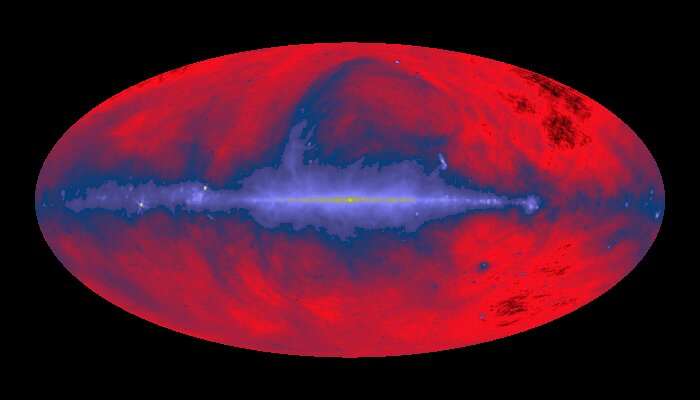How the world’s biggest radio telescope could be used to search for aliens

In 2016, China’s Five-hundred-meter Aperture Spherical radio Telescope—the largest single-aperture radio telescope in the world—gathered its first light. Since then, the telescope has undergone extensive testing and commissioning and officially went online in Jan of 2020. In all that time, it has also been responsible for multiple discoveries, including close to 100 new pulsars.
According to a recent study by an international team of scientists and led by the Chinese Academy of Sciences (CAS), FAST might have another use as well: the search for extraterrestrial intelligence (SETI). Building on their collaboration with the nonprofit science organization Breakthrough Initiatives, the authors of the study highlight the ways in which FAST could allow for novel SETI observations.
The team included members from the FAST Collaboration, the Chinese Academy of Sciences (CAS), the University of California Berkeley, the Swinburne University of Technology, Breakthrough Initiatives, the SETI Institute and multiple universities. They were led by Di Li of the CAS Key Laboratory of FAST and the University of CAS, and their study recently appeared in the journal Research in Astronomy and Astrophysics.
To put it plainly, the FAST array has its fair share of advantages over previous radio telescopes because of its sheer size. For starters, with a primary surface measuring 500 meters (1640 feet) in diameter—and a maximum effective aperture of 300 meters (984 feet), FAST is currently the largest radio telescope in the world and can access a much larger region of the sky than the Arecibo radio telescope.
As Dr. Li explained to Universe Today via email: “The main advantage of FAST is its effective collecting area. FAST forms a parabola of 3000-meter diameter, and a total collecting area in the L-band (covering neutral hydrogen, etc.), which is larger than those of any other telescopes, including VLA, Effelsberg, Arecibo, GBT, etc. In conjunction with the state-of-art receivers, FAST provides the best gain toward point sources, which SETI signals are.”
Artist’s impression of BLI, the largest SETI survey in history. Credit: Breakthrough Listen
The FAST telescope was also conceived with the possibility of SETI research in mind. Hence, the Breakthrough Listen Initiative (BLI) signed a memorandum of understanding with the CAS’ National Astronomical Observatories (NAOC) in 2016 for the sake of future collaborations that would bring FAST into their network of radio telescopes.
As part of the nonprofit research group Breakthrough Initiatives, BLI is a 10-year, $100 million effort to “conduct the most sensitive, comprehensive, and intensive search for advanced life on other worlds.” These efforts currently rely on three telescopes, which includes the Green Bank Telescope, the Parkes Radio Telescope and the Automated Planet Finder.
Another major advantage is the fact that FAST is equipped with a 19-beam focal-plane feed horn receiver array, which greatly enhances its field of view. Compare this to the seven beams of Arecibo and the 13 beams of the Parkes Radio Telescope, both of which have provided unprecedented speed for SETI surveys and efficiency in filtering out radio frequency interference (RFI) from Earth-bound sources.
The FAST telescope also benefits from the latest in computing hardware, software and networking. “In addition, we have successfully tested a novel observing mode to allow for simultaneous data taking for different purposes,” said Li. “In particular, this is the first radio telescope to record pulsar and hydrogen data streams for large-scale surveys.”
Artist concept of the Transiting Exoplanet Survey Satellite and its 4 telescopes. Credit: NASA/MIT
This same technology, says Li, allowed him and his colleagues to design and commence a new survey called the Commensal Radio Astronomy FAST Survey (CRAFTS). This survey will search for various radio sources—like pulsars, fast radio bursts (FRBs), galaxies and hydrogen—all at the same time. Once FAST is equipped with SETI instrumentation, Li anticipates that CRAFTS will be able to provide substantial time to SETI while still carrying out its other primary science goals.
The team included in their study some thoughts and suggestions on what FAST will search for. As Dr. Li indicated, these will include surveys of exoplanets that have been discovered by next-generation telescopes like NASA’s Transiting Exoplanet Survey Satellite (TESS) in the hopes of finding evidence of extra-terrestrial communication:
“In addition to blind search, we will target TESS planets and the Andromeda galaxy. In terms of equivalent isotropic radiation power (EIRP), FAST will be sensitive enough to detect any human-like technologies on TESS planets, i.e., a world with a slightly more powerful radar than that of Arecibo. At the distance of Andromeda, FAST could detect a Kardashev type II or any civilization more powerful.”
So FAST could enable the detection of civilizations that are so advanced they’ve managed to harness the power of their entire star system? And it could do this while simultaneously searching for other cosmic radio sources? Now, that sounds promising. In the meantime, Breakthrough Listen’s 10-year survey goes on, and the data continues to accumulate.
If there is evidence of intelligent life out there, we are closing in on it.



 Creators of mankind
Creators of mankind Description of “Tall white aliens”
Description of “Tall white aliens” Where they came from?
Where they came from? About hostile civilizations
About hostile civilizations The war for the Earth
The war for the Earth “Tall white aliens” about eternal life
“Tall white aliens” about eternal life Video: “Nordic aliens”
Video: “Nordic aliens” Aliens
Aliens Alien encounters
Alien encounters The aliens base
The aliens base UFO
UFO Technology UFO
Technology UFO Underground civilization
Underground civilization Ancient alien artifacts
Ancient alien artifacts Military and UFO
Military and UFO Mysteries and hypotheses
Mysteries and hypotheses Scientific facts
Scientific facts


















